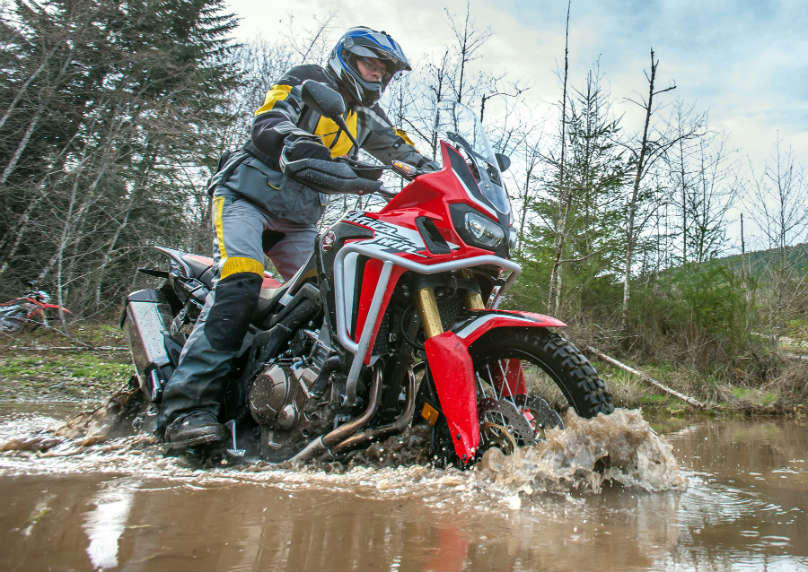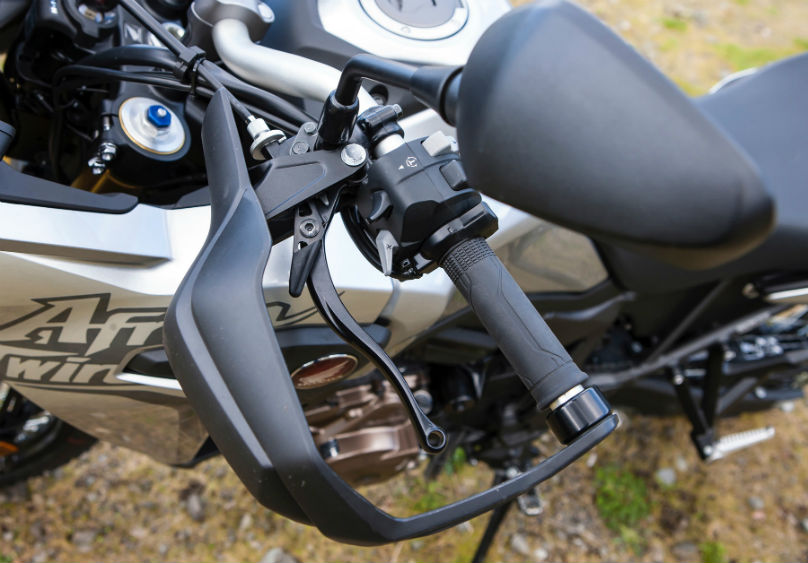Dans la suite des essais au Canada, celui de Wheels
http://www.wheels.ca/car-reviews/rebirth-of-a-legend-honda-africa-twin-2016/
Rebirth of a legend: Honda Africa Twin 2016
Eventually, we graduated to the Africa Twins, gingerly at first, recognizing that the three bikes that Honda Canada had imported from Europe were, at that time, the only ones in North America.
THE PROS & CONS
What’s best? The Africa Twin finally comes to Canada in a new, improved and innovative package with one litre power, all-road ability, an optional dual clutch automatic transmission, dynamic power and with traction mode choices, all starting at an affordable $13,999.
What’s worst? Arrggh! The best colour combo (red) is only available in the manual model. The bike is also really too big for real trail riding. But who cares? And the DCT adds $1,000 and 10 kg but, after a test ride, customers might find it worthwhile.
What’s interesting? In markets such as Europe, more than half of the customers are opting for DCT automatics when available. Bow to the inevitable. It will happen here too.
VICTORIA, B.C. – You don’t have to go far to find the more remote parts of Vancouver Island.
There be monsters here – bears, cougars, towering Douglas firs, massive mountains scarred with open wounds of clear-cut nakedness, the contours of continental upheaval edged with narrow highways, logging roads and rudimentary trails hacked out of the wilderness.
Our weapon of choice for this venue was the 2016 Honda Africa Twin, a legend reborn in modern form.
We lined up on a log-sorting paved pad, a gaggle of motor journalists dressed in new KLIM adventure suits, a hodgepodge of expertise and ignorance, with proficient off-roaders, pro sportbike racers and others, like me, just simple street riders.
Canada’s premier off-road instructor, Clinton Smout, tried not to look askance at occasional street boots and full-face helmets, in lack of proper footgear, motocross lids and goggles, before motioning us toward our mounts.
Honda had brought other bikes boasting a mix of on-road/off-road pedigrees – the dual purpose CRF250L and XR650L, and more civilized middleweights with milder off-road capabilities like the CB500X and NC750X.
We worked our way through that lineup, starting with paved lot braking exercises, slow-mo figure-eights and “snakes and ladders”, before moving off the asphalt for gravel, grass, dirt and mud, hopping over logs, attempting water crossings and strafing dust-choked logging roads.
Eventually, we graduated to the Africa Twins, gingerly at first, recognizing that the three bikes that Honda Canada had imported from Europe were, at that time, the only ones in North America.
The new 2016 Honda CRF1000L Africa Twin is an adventure bike designed for “any road, anywhere”, a modern successor to the originals of the past. The first XRV650 Africa Twin was introduced in the late ‘80s, riding on the coattails of Honda’s Paris-Dakar successes, evolving into more powerful, more road-capable XRV750 models that lasted until 2003. Canadians could only envy from afar as none were ever sold in North America.
Compared to the last version of its predecessor, the new 2016 model is more powerful, featuring a 998 cc parallel twin engine instead of the 742 cc V-Twin. Honda engineers elected for the compact packaging, mass centralization and lowered centre of gravity of the parallel twin, but they made a nod to tradition with a 270-degree phased crank layout that simulates the traditional, uneven power pulse of a 52-degree V-Twin.
The new bike is a little shorter in body length, a little longer in wheelbase and a little taller in the saddle (850-870mm seat height).
It is also heavier and features a bigger 18-inch rear wheel, a smaller 18.8-litre fuel tank offset by improved fuel economy number. It has better braking, more suspension travel and modern innovations and technologies with over 32 patents pending.
Components worth considering include:
- A high-tensile-strength steel frame that takes design cues from the CRF450 rally bike, offering sturdy simplicity and fix-anywhere, welding repairability.
- A choice of either a 6-speed close-ratio manual transmission or Honda’s unique 6-speed DCT automatic transmission offering “Drive” Mode, three stages of “Sport” mode and left-hand fingertip or optional foot-lever manual shifting. Incline detection helps the DCT adapt of off-road situations.
- A “G” button-activated off-road mode setting that reduces clutch slip and offers sharper shifts for gravel/trail conditions.
- Standard Combined ABS braking with Adaptive Rear ABS Cancelling button that allows the rider to turn the ABS off on the rear wheel for off-road riding.
- Honda Selectable Torque Control with three setting choices that uses the ABS sensors and ECU torque management to control rear wheel spin.
Our off-road refresher course reinforced stand-up riding techniques, the bike gripped between the legs, assisting the steering with weight shifts on the foot pegs, hands loose on the grips and two-fingered brake and clutch control, getting us through tasks that the Africa Twin passed ably.
Now, we can’t pretend that the biggish Africa Twin is a trail bike. Honda Canada already has a varied lineup of agile competition motocross, trail and dual sport dirt bikes to meet those challenges. But with its responsive power, versatile adjustable modes, 250 mm ground clearance, knuckle guards, aluminum skid plate engine protection and off-road capable suspension with 230 mm/220 mm travel (front/rear), the 2016 Africa Twin can definitely keep going when the going gets tough.
On day two, three of us opted for a long scenic ride along the West Coast Road, a smoother, more relaxed trip on pavement where, frankly, probably 90 percent of Africa Twin riding will actually occur. We switched through three models in Honda’s adventure lineup – the CB500X, NC750X and the Africa Twin.
The Africa Twin soon became my favourite, its tall bike architecture custom-made for my 6’3” frame. You might expect the front end to register as a touch light and unstable given the 45 mm Showa front forks’ long suspension travel but the bike’s 49.1/50.9 percent (front/rear) weight balance makes for a poised and planted feel on the road. The engine power pulse and aggressively tuned exhaust note seemed a slightly unnecessary affectation to me, but a charming one, nonetheless.
And the DCT is easy to get used to. Some riders will find it hard to give up the nostalgic tradition of manual shifting but the quick downshifts when you pin the throttle add an instant surge of almost VTEC-like power.
It’s a power surge that will have you grinning in your helmet.
The adventure riding segment is booming, and based on pre-orders made before the bike even comes to Canada this May, riders looking to push the boundaries with go-anywhere ability with new levels of toughness and technology have already added the 2016 CRF1000L Africa Twin to the short list of capable contenders.
Honda CRF1000L Africa Twin 2016
ENGINE: 998 cc four-stroke eight-valve Parallel Twin with 270-degree crank and unicam (94 hp, 72 lb/ft)
TRANSMISSION: Six-speed constant mesh manual or six-speed DCT model. “O”-ring sealed chain final.
FUEL ECONOMY: Est. 4.6L/100km
SUSPENSION: Front 45 mm Showa fork (230 mm travel); Rear Showa shock (220 mm travel)
WHEELS & TIRES: 90/90-R21 tube type; Rear: 150/70-R18 tube type.
BRAKES: Front 310 mm dual wave, four-piston calipers; Rear 256 wave disc, two-piston caliper.
SEAT HEIGHT: 850-870 mm
WHEELBASE: 1,575 mm
CURB WEIGHT: MT 232 kg; DCT 242 kg
COLOURS & PRICES: Africa Twin (6MT) Matte Black Metallic $13,999; CRF Rally Africa Twin (6MT) Red, Black, White $14,299; Africa Twin (DCT) Silver $14,999.
- See more at: http://www.wheels.ca/car-reviews/rebirth-of-a-legend-honda-africa-twin-2016/#sthash.xvyUNFVy.dpuf




Aucun commentaire:
Enregistrer un commentaire